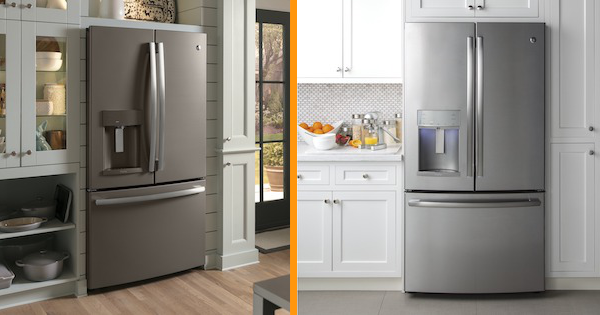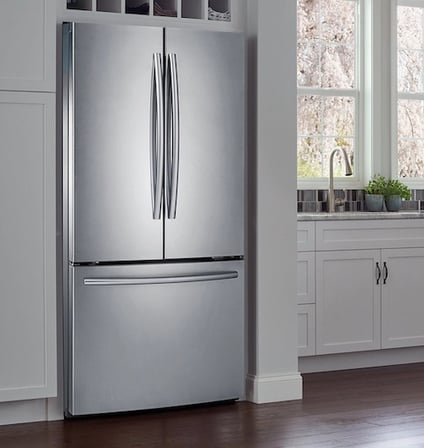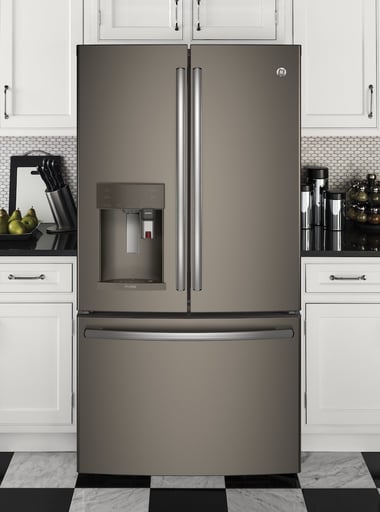
There seem to be more and more color options for appliances coming to the market in recent years. For over a decade, stainless steel appliances were king in the marketplace for anyone building a new home or remodeling an existing home. Stainless steel is still the most popular option, but that may be changing. New colors like black stainless steel, slate, and black slate, among others, are catching on with consumers.
If you're not sure if you're ready for something new or not sure what makes slate different, we'll go over stainless steel versus slate appliances to help you decide which of these might be the best option for you. Let's take a look.
Table of Contents
Watch Our Quick Video Comparison!
Stainless Steel Appliances
Stainless steel is an industry staple that has been incredibly popular for more than a decade. Almost every manufacturer offers stainless steel, which gives consumers a wide variety of brands to choose from to get that look. The only real aesthetic concern with stainless steel appliances is matching handles between different brands. With the introduction of smudge resistant stainless steel, there may be slight variations in the look of the stainless steel from one manufacturer to the next but it's a relatively minor concern. As far as pros and cons go, here are some important ones to keep in mind.

Pros
-
Stainless steel provides a clean modern look that is universally viewed as high-end compared to the more traditional black or white appliances.
-
Stainless steel appliances have been popular in the industry for over 10 years and they are likely to remain popular for the foreseeable future. There is little chance that the color will be discontinued.
-
Many manufacturers are developing or have already released stainless steel that is resistant to fingerprints.
-
The variability in the look of stainless steel from one manufacturer to another is relatively low in most cases, so mixing and matching brands is relatively easy.
Cons
-
If you don't purchase fingerprint resistant stainless steel, fingerprints can be a nuisance. The traditional stainless steel finish seems to show every fingerprint and water spot.
-
Stainless steel is very easily damaged. These appliances can be dented during installation, moving or even from everyday family mishaps like a child riding a large toy into the product. Once they are dented, the dents really stand out.
-
If newer trends like black stainless steel and slate take hold in the industry, stainless steel may lose its place as the most desired look for home resale value.
Slate Appliances
Slate is a relatively new color in the appliance industry initially released in 2013 and is offered exclusively by GE Appliances. Unlike the shiny finish of stainless steel, slate is a gray tone with a matte finish, inspired by stone. They have stainless steel handles for contrast. For those looking for an alternative to stainless steel, slate appliances may be a good fit. Let's weigh the pros and cons.

Pros
-
Slate appliances are different. Having slate in your kitchen will set it apart from the vast majority of kitchens in your neighborhood.
-
Slate appliances are considered high-end and will definitely give your kitchen a more high-end look than traditional black or white appliances.
-
It is available in the main GE Appliances line as well as their high-end GE Profile line, so you have a lot of variety to choose from within the brand. GE offers a lot of options in slate. Compare this to the limited lineup some manufacturers offer in black stainless steel!
-
Slate is a matte finish that is resistant to fingerprints and smudges by nature and may be slightly more durable against everyday wear and tear than stainless steel.
-
Slate offers a warm earthy look that is a contrast to the cool clean look of stainless steel. This may be ideal for certain kitchen designs and decorating tastes, particularly with the hot trend of white cabinetry.
- The contrasting stainless steel handles and knobs allow it to match with other stainless, chrome, or silver hardware in your kitchen, like a chrome sink faucet.
Cons
-
The only manufacturer offering slate is GE Appliances. If you want this color option, you are going to have to purchase GE. You won't be able to mix and match brands in your kitchen if you want to keep the color consistent.
-
Slate is a relatively new color in the appliance industry. While GE slate appliances have sold very well, it is not certain how long the color will remain in production. GE has no plans to discontinue the color but as a consumer you must be mindful that it is a niche product offered by only one producer.
-
Slate is not as popular as stainless steel, and with the advent of black stainless steel, it remains unclear where the industry is heading. If you are concerned about near term resale value of your home, slate may not be as widely recognized by home buyers.
CLICK HERE TO EXPLORE ALL GE SLATE MODELS
Summary Comparison
| Stainless Steel | Slate | |
| Matches With: | Everything, but has a cold feel to it | Many color schemes, especially white and warmer/richer colors |
| Fingerprints: | Plain stainless is hard to clean; fingerprint resistant options hide fingerprints better | Fingerprint resistant |
| Available From: | All major manufacturers | GE only |
| Durability: | Slate may be slightly more durable and scratch-resistant than stainless steel (unlike black stainless, slate's durability doesn't seem to be an issue) | |
| Odds of Being Discontinued: | Highly unlikely since it is still the go-to premium finish | Quite unlikely since it has been relatively popular and has been around since 2013 |
| Ideal For: | People who want a familiar high-end finish that is easy to match across different brands | People who want a unique high-end look for their kitchen |
Our suggestion: head out to a local retailer and lay your hands on some GE slate appliances. When you see them in person, you'll really get a feel for whether they might be a good option for you. In our experience, the feedback from customers who purchased slate products has been quite good. At the end of the day, the decision between stainless steel and slate will be up to you.
We hope you enjoyed this article. Please leave a comment below. We'd love to hear from you!
Editor's Note: This blog was originally written in August of 2017 and has been completely revamped and updated for accuracy as of the publication date noted above.



